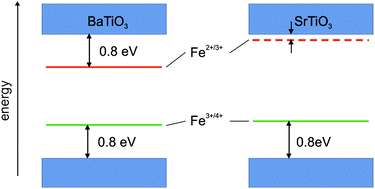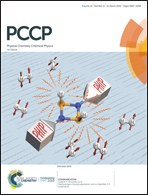The energy level of the Fe2+/3+-transition in BaTiO3 and SrTiO3 single crystals†
Abstract
An approach to determine the defect energy levels of the Fe impurities in BaTiO3 and SrTiO3 single crystals using electrical conductance measurements is presented. The defect levels are obtained from the dependence of the activation energy of electrical transport on the oxygen vacancy concentration, which is varied by stepwise re-oxidation of a reduced sample. An energy level at 0.7–0.8 eV below the conduction band minimum ECB is identified for BaTiO3, which can be assigned to the Fe2+/3+-transition in good agreement with literature. In contrast, the conductivity of Fe-doped SrTiO3 does not show a defect energy level in the upper half of the band gap, indicating that the Fe2+/3+-transition in SrTiO3 is near the conduction band minimum. The often reported alignment of defect energy levels, which is fulfilled for the Fe3+/4+-transition in BaTiO3 and SrTiO3, does not hold for the Fe2+/3+-transition in these compounds. This limits the applicability of Fe-doped SrTiO3 as a model system for studying resistance degradation in acceptor-doped high-permittivity dielectrics.



 Please wait while we load your content...
Please wait while we load your content...